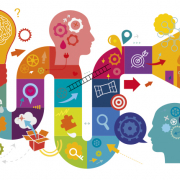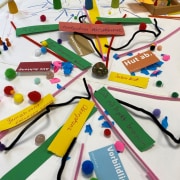New learning, learning – Trainer first!
New learning primarily challenges those that teach today.
As the OECD Pisa-Study 2018 concludes, students are only as good as their teachers. And in this case, what applies to teaching students can also be transferred to HR Learning & Development.
Internal qualification experts such as trainers and HR developers are a decisive target group. As multipliers they are effectively building the skills of staff while acting as guides for current changes.
Our case illustrates how to transform a conventional train-the-trainer programme into a modern, forward-looking qualification approach.
Neue New Teachers, New Learning
Formats
A premium automotive manufacturer finds itself confronted with various L&OD challenges. There is, for example, the central requirement to quickly prepare the workforce for the digital future.
Internal trainers and HR developers are experienced and well trained, but most of them still use the same methods as 20 years ago. They, themselves, have a considerable need for development when it comes to new learning.
At the same time, the outlined change creates an increasing learning pressure, requiring the timely implementation of new teachers and qualification format.
Obviously, the manufacturer is not alone in this challenge. Well-qualified trainers with experience in “future learning” are a rare find on the current market. Those that are newly recruited for this role therefore demonstrate a broad range of different skills and show a wide variety of development needs.
How “teaching” has been taught so far
Our client’s previous Train-the-Trainer programme was designed as a classic “one-size-fits-all” curriculum. Developed many years ago, it comprised several classroom modules and accompanying self-learning units in PDF format. The programme is representative for a traditional understanding of “blended learning” containing all things relevant for the qualification of this target group: brand, company, role, methodology, didactics and application.
Over the time, the programme had grown to twelve (12!) classroom days and has always been identical for each participant.
From curriculum to adaptive concept, from teacher to learning guide
The architecture for this contemporary “Train-the-Trainer” programme was influenced by two central considerations: How does a qualification concept for the future look which meets the above challenges and requirements in equal measure? And how is the role of the learning guide of the future defined?
It quickly became clear that a new version of the programme needed to be designed to adapt to individual qualification needs while considering a variety of prerequisites. It was therefore built as an adaptive qualification concept that can map individual learning paths. Content is segmented in micro-teaching units and can be accessed individually.
Of course, new learning is at the centre of meeting future qualification needs. Virtual learning modules, community learning, workspace learning and virtual learning support make up the majority of the programme. Where live training adds the highest value, classroom modules are complementing the course. Here, too, new designs and methods are used to strengthen learner’s self-efficacy.
We could also say: New Learning is learned through New Learning – by the new “trainer”. In the future, this trainer will be more of a learning companion who supports individual learning at the workplace and assists the learner in shaping his or her own learning path. This is fostered by feedback and by purposeful questions, or by individually arranged exercises.
In this way, learners develop into learning designers and co-moderators of their own qualification – and, thus, from trainer to enabler.
Qualification in tomorrow’s zeitgeist
The conception and coordination phase took place in several iteration loops with the customer and began with facing several pending decisions: Which competence model will be used and how will it be operationalized? Which resources are used to make implementation as lean as possible?
The overall concept follows the competence model of ability (transfer into application or action), knowledge and attitude (motivation/ mindset) and provides learning nuggets for the development of all competences. First, the learner explores his own learning fields in a development centre to then design his individual learner journey based on this experience.
Following the 70-20-10 approach of “Future Learning”, live workshops and small modularized knowledge bits are available virtually and on the job. Mandatory modules are combined with “on demand” offers. Throughout the programme, learners take part in community learning. Regular blogs and small tasks promote learning and exchange in different group sizes and compositions. They ensure learning transfer and enable the mutual exchange of experiences and support.
Specific skills, such as methodology and didactics, are taught in accompanying virtual classroom training sessions. With a learning guide as a sparring partner, the learner carries out an individual project enabling him to apply and test what he learned.
The good old “certification” at the end of the programme is a classroom event. It is somehow the tribute that is still “paid” to the old world. But that also makes sense – and certainly makes you proud. The event is combined with a future workshop and marks the final shift to new learning.
Because here, we are also talking about a change in learning culture …
Learners start with a virtual information phase before the actual start of the programme. This creates transparency in communication and an understanding of the new learning process. The participants get to know Community Learning right from the start.
This is the current status quo of the programme.
The first virtual tasks of the now following pre-phase make learners more familiar with this new learning format and prepare them for the live kick-off event.
Parallel to the information phase, details are currently being sketched out. Here, too, there is close coordination and iteration with the customer. So the journey has just begun.
Quite exciting.
Our customer is shaping the future – and we’re the right partner.







